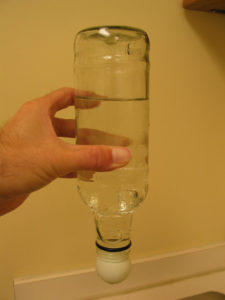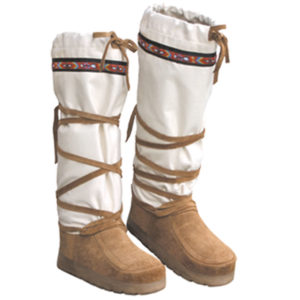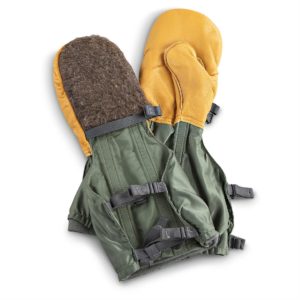(Editor’s note: Welcome to the next installment of our “Ask a Survival Guy” series of blog posts. We encourage you to submit a question. The founder of Midwest Native Skills, Tom Laskowski, might just answer it as part of this regular feature!)
Question:
When I’m camping in the winter, is there anything I can do to not wake up in the morning shivering?
Answer:
Yes, in fact some of my nicest memories of camping are from the winter trip we took up in northern Maine where the night time temperatures bottomed out at 35 below zero and that’s without the wind chill! The most important thing to do is wear wool, but here is a list of other things to consider to make those winter camping trips more enjoyable cozier.
#1—Buy a down-filled sleeping bag.
Yes, they are more expensive. Yes, you need to be more conscientious and keep them dry. (Put them in a garbage bag as an extra measure of precaution.) Yes, they pack down to a very small size, they are much lighter to carry than a synthetic bag, and they’re very cozy and comfortable to crawl into. Overall, a down sleeping bag is just cozier and will make you feel warmer than a synthetic bag.
#2—Buy the correct “temperature rated” bag.
When buying a sleeping bag, the “rating” is the temperature at which the bag will “keep you alive to” and not the temperature it will “keep you comfortable at.” You also need to take into account if you are a warm sleeper or cool sleeper. When I buy a sleeping bag, I at least add 10 degrees to the advertised rating of the bag to determine which temperature range I will use.
For example, if the bag is rated as a “Zero Degree” bag, I will never take it on trip where I expect the temperature at night to ever get close to 10 degrees above zero (10 degrees above the rating of the bag). If I’m looking for a summer sleeping bag here in Ohio, I’ll look for a down-filled bag with a rating of +30 degrees, since I’m not expecting the summer nighttime temperature here in Ohio to go below +40 degrees in June, July, or August. A winter bag should be rated at least at 0 degrees, but my recommendation would be a -20 degree bag, since you can always unzip it a little if you get too warm.
#3—Never, ever sleep in the socks you wore all day.
Your feet sweat. In fact, they can sweat up to a pint of water during an eight-hour period. Just before you go to bed, take off the socks you’ve been wearing all day and let your feet “air out” for about one minute. Yes, it may be cold in your tent, but let the moisture evaporate off of your skin for that 60 seconds. Then put on a dry pair of wool socks, preferably one full size larger than your normal sock size. (If you typically wear a size 10, then your nighttime socks should be a size 11 or 12. You do not want to have your socks too tight, as to restrict circulation to your feet and make your feet colder). I simply keep an extra pair of socks in the bottom of my sleeping bag.
#4— Spice up your feet with Cayenne pepper.
Sprinkle some cayenne pepper in your socks before you put them on in the morning. Cayenne is a mild irritant, irrating enough to cause an increase in blood flow to the upper layers of your skin but not irrating enough to cause you discomfort. The increase in blood flow will give you a little extra warmth for your toes. A friend of mine in Maine simply takes one of those Cayenne Pepper “00” health food capsules and opens it up and sprinkles ½ in each sock. I believe in overkill and just take a small shaker with me on my winter trips and put a “shake” in each sock. Either way , we both have toasty feet on the winter camping trips we go on.
#5—Never store your sleeping bag all stuffed up in its stuff sack.
It’s the “loft” or “dead air space” that keeps you warm. If you store your sleeping bag all compressed, it will never spring back to its fully uncompressed state. Thus, it robs you of some of that precious “dead air space” (or more importantly, “precious heat retaining space”). Store all of your sleeping bags completely uncompressed and unrolled in the attic or out on top of a spare bed.
#6—Keep your water bottle upside down.
You need to keep hydrated at night. If you don’t, then your total blood volume will decrease slightly and your body will need to make a decision as to where to concentrate the blood to keep you alive: your core, where your heart and lungs are, or your toes and finger tips, where . . . well where nothing really is.
You guessed it: your toes and fingertips lose. They’ll get cold and you’ll wake up, since your toes and fingers will be freezing and you can’t go back to sleep. So drink water before you go to bed. And since water freezes from the top down, store your water bottle upside down, so that if it does freeze during the night, when you flip it over to get a drink, there will be unfrozen water at the spout.
#7—Keep a “pee bottle handy”
Instead of getting out of a warm sleeping bag to observe Orion’s Belt in the middle of the night, have a well-marked bottle with its screw cap on to pained with some glow-in-the-dark paint is a nice convenience item to have in the tent with you.
#8—Wear a hat.
A wool “watch cap” is best, but make sure that it’s not tight. As your mother told you, we lose 80% of our heat though our head, so a cap will help you retain a good part of that heat. The old saying “If your feet are cold, put on a hat and if your head is cold put on some socks” is a pretty good adage to follow.
#9—Do not sleep naked.
In the winter, you may want to consider sleeping in a warm-up suit (top and bottoms) or a pair of merino wool long underwear. Both will add another layer of insulation and warmth to your nighttime slumber. Whichever you choose, they should be loose fitting. In fact, the merino wool long underwear could be one size larger than you would normally wear to ensure it’s not constricting you in any way during the night.
#10—Do not drink alcohol.
Alcohol is a vasodilator, which means it causes the blood vessels in your body, especially the small capillaries just under the surface of your skin, to dilate. First, this dilatation causes a higher volume of blood to be brought to the surface of your skin, making the color of your skin look slightly redder in color and making you feel warmer. In reality, though, it causes you to lose heat from your skin more quickly. Second, the feeling of warmth could also cause you to begin to sweat, making your skin wet, and through your sweat, evaporation make your skin even colder. Third, drinking reduces the body’s ability and tendency to shiver, which is one of your natural resources to help keep your body’s warmth close to your skin.
#11—Never, ever sleep on the ground.
This is just a pure matter of thermodynamics. Heat always travels from a hotter body to a colder body. In the case of sleeping outside, your body is 98.6 degrees Fahrenheit, while the ground is 52 degrees Fahrenheit or colder. The heat from your body will try to warm up the entire earth all night long. YOU WILL LOSE.
When you wake up stiff and sore in the morning, you’ll blame it on the hard ground. In reality, though, your aches and pains are caused by your body working all night to expend energy in its attempts to warm up the earth. You need to sleep on a ground pad made of closed-cell foam. Some brand names are Thermarest, Ridge-rest, and Sleepingo, and they range in price from $50 to $100. If you need to make a “ground pad” out of natural materials like dry leaves and pine needles, the thickness needs to be between six and eight inches to insulate you from the cold ground.
Note: An air mattress will NOT work as a ground pad. The air inside an air mattress can circulate, so the lower cold air inside the air mattress can rise and move to the top where your body is. This cools you off and pulls your body heat away. Ground pads MUST be made of closed-cell foam, so air circulation is not possible.
#12—Have a Reese’s Peanut Butter Cup handy.
This popular candy bar has two parts. The first part is the chocolate, which when eaten, provides a fast burst of energy that can quickly be converted to heat. The second part is the peanut butter, which is carbohydrate-based and provides a longer sustained source of energy (heat).
#13—If you’re a man, don’t shave.
Having a few days of beard growth provide a thin layer of “dead air space” next to your facial skin. This dead air space will give you some insulation on your face, thus keeping you a little warmer.
#14—During the day, when moving, wear a shamagh.
A shamagh (pronounced “shaw mawga”) is Middle Eastern headwear that is extremely versatile, depending on the way it’s wrapped around the head or neck. Learn several different head-wraps so that the shamagh covers the forehead, cheeks, and back of the neck. It will act as a windbreaker and keep you warm.
#15—Buy a pair of mukluks for your footwear.
Mukluks are the footwear of the Inuit and Cree Indians of the north country for one reason: they work! They are made of untreated, uninsulated, non-waterproofed, single-layered canvas with a rubber bottom. The trick to keeping your foot warm is having a 9 millimeter wool boot liner with a wool felt insole that you place in the bottom of the boot to insulate your foot from the cold ground.
Steiger Mukluks (www.mukluls.com) are one of the premier mukluk makers in the country and have sizes up to 15. Expect to pay around $200. Order one size larger than your boot size or simply trace your foot on a piece of paper to have a custom set made at no extra charge. The only stipulation is that they can only be worn at temperatures below 20 degrees Fahrenheit. Above that temperature, the snow will melt on them, they will get wet, and your feet will freeze. Above 20 degrees Fahrenheit, you will need to wear rubber boots, such as Tingley Rubber boots. Yes, your feet will sweat in them and eventually your feet will get cold, so change your socks two or three times on those warmer days in order to be comfortable.
#16—Wear wool.
That’s wool pants, merino wool long underwear, a thin wool shirt, a wool sweater, and wool socks. The two sources I can direct you to for the shirts and sweaters are Woolrich and Pennington Wool. Wool is expensive, but it will last a lifetime. The long underwear will cost about $50 for the top and $50 for the bottoms. The shirt will be around $100. The sweater is $150 and the pants about $250. The one thing you DO NOT want to ever wear on a winter camping trip is cotton blue jeans. When (not if, but when) your cotton jeans get wet, they will suck your body heat away 25 times faster than when your cotton clothing was dry.
#17—Windproof and waterproof your outer shell.
Besides being waterproof and made of a good wind-stopping material, your outer shell should include wire “snorkel” hood with a fur trim. One jacket that I like is the F.A.T. Goose SAGA Collection Norden HoodedGoose Down Jacketed Parka with real coyote fur.
#18—Wear mitten-type gloves (not the type with “fingers”).
Mitten-type gloves allow each individual finger to keep its neighbor warm, thus allowing your entire hand to keep itself warm. Fingered gloves isolate each finger, making it nearly impossible for the small amount of blood going to each finger to keep itself warm. The Military Surplus N4B Gen 2 Artic Extreme Cold Flyers Mitts (with liners) are an excellent choice.
Follow these tips and your winter camping trips should be a little more enjoyable. Oh, did I mention you should wear WOOL on your camping trip?
